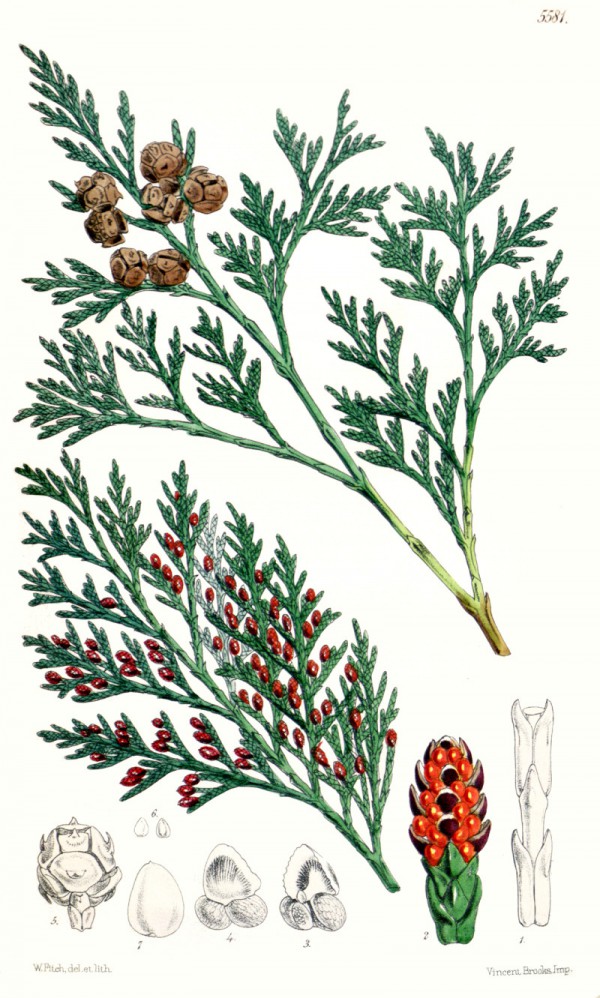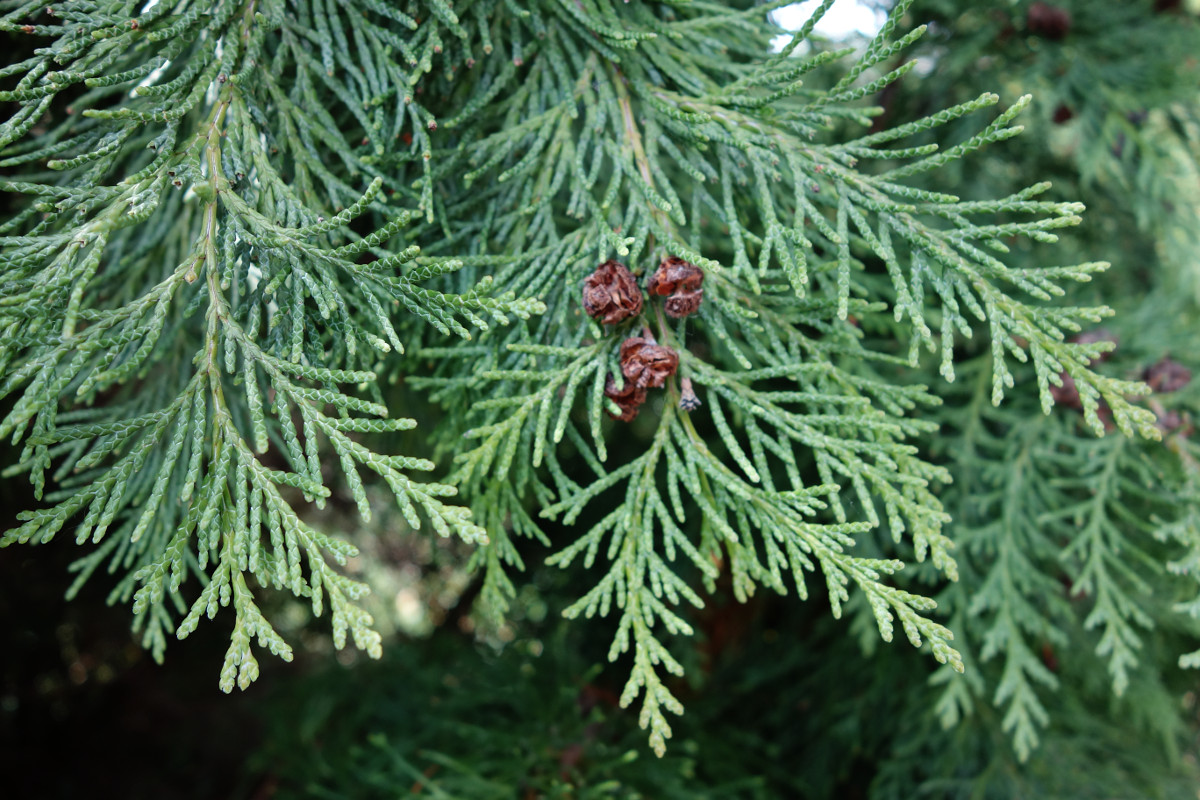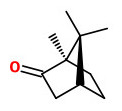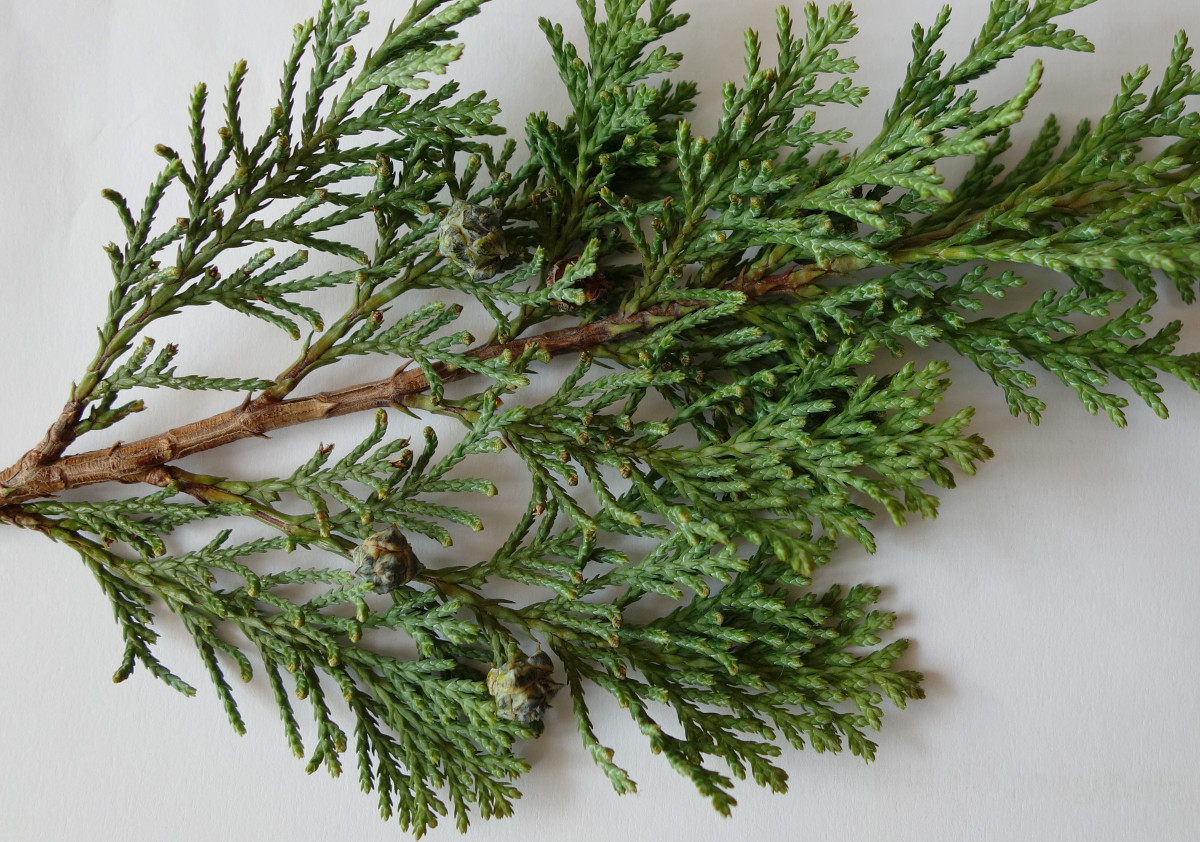Chamaecyparis lawsoniana (A. Murr.) Parl. - Cupressaceae - Port Orford cedar, Lawsons Scheinzypresse, Oregon-Scheinzypresse, Lawson-Weißzeder
Evergreen tree, up to 60m high, native to Oregon and northern California; male inflorescences red, young female ones metallic blue; cones globose, 0.8-1cm in diam.
The fragrant wood oil is acting diuretic, as seen on inhalation of the volatiles during work in saw mills.
[Dausien's grosses Buch der Bäume und Sträucher., V Matoušová, J Ostmeyer, Werner Dausien, Hanau 1995]
„The leaves are scale-like, 3-5 mm long, with narrow white markings on the underside, and produced on somewhat flattened shoots. The foliage gives off a rather pungent scent, not unlike parsley… Several hundred named cultivars of varying crown shape, growth rates and foliage colour have been selected for garden planting… Its lumber is also known for its highly fragrant ginger aroma.“
https://en.wikipedia.org/wiki/Chamaecyparis_lawsoniana
„The volatile fractions of Chamaecyparis lawsoniana and C.pisifera, although qualitatively analogous and fairly rich in limonene, were differentiated from each other by the absence of δ-3-carene and bornyl acetate in the former, and a moderate δ-3-carene and bornyl acetate content in the latter. Both contained appreciable amounts of the acetate of the relatively rare sesquiterpenoid oplopanone, and the diterpene hybaene, both of which were identified by 1H-,13C-NMR and mass spectrometry. No character impact compound could be identified in the oils.“
[Volatile Fractions of Chamaecyparis lawsoniana (A. Murray) Parl, and Chamaecyparis pisifera (Sieb. et Zucc.) Endl. var. filifera. Identification of oplopanonyl acetate . De Pooter, H. L., Vermeesch, J. R., De Buyck, L. F., Huang, Q. L., Schamp, N. M., De Bruyn, A., Journal of Essential Oil Research, Vol.3(1), 1991, 1-6]
Main components of commercial wood oils of C.lawsoniana were α-terpineol (14.3%), δ-cadinene (8.2%), α-pinene (6.5%), camphor (5.9%), α-fenchol (5.5%), α-cadinol (5.3%), fenchone (4.7%), and α-muurolene (4.2%). Olfactory interesting minor components were eucalyptol, cis rose oxide, citronellal, bornyl acetate, myrtenal, citronellyl acetate, isoborneol, borneol, citronellol, and myrtenol e.g.
[Commercial “rose of cedar” oil, the wood oil of Port Orford cedar, Chamaecyparis lawsoniana (A. Murray) Parl.(Cupressaceae). Tucker, A. O., Maciarello, M. J., Karchesy, J. J., Journal of Essential Oil Research, Vol.12(1), 2000, 24-26]
„The essential oil of the aerial parts of Chamoecyparis lawsoniana was obtained by hydro-distillation and analyzed by GC, GC-MS and 13C-NMR spectroscopy. Thirty-Five components, representing 99.4 % of the oil was characterized. The major components of the oil were terpinen-4-ol (22.0 %), sabinene (21.0 %), camphor (7.8 %), citronellol (7.3 %), γ-terpinene (7.0 %).“
[Identification of volatile oil components from aerial parts of Chamaecyparis lawsoniana by GC-MS and 13C-NMR methods. Emami, S. A., Massoomi, H., Moghadam, M. S., Asili, J., Journal of Essential Oil-Bearing Plants, Vol.12(6), 2009, 661-665]
The coniferous scent of C.lawsoniana released by touching the needles is quantitatively based on limonene (45.0%) and sabinene (22.9%). Olfactory more important are cis-rose oxide (0.01%), cis- and trans-sabinene hydrate (0.1% and 0.4% resp.), bornyl acetate (0.2%), myrtenic acid methyl ester (1.5%), α-terpinyl acetate (0.4%) and 3-car-10-enoic acid methyl ester (0.01%). Minor amounts of (Z)-4-decenal (0.02%) contribute an unmistakeable algae-related note.
[Scent of a vanishing flora, Roman Kaiser, 2011, 141]
„The essential oils extracted from the young stems and leaves of Chamaecyparis lawsoniana (A.Murray) Parl. have been analysed by Gas Chromatography and Gas Chromatography coupled to Mass Spectrometry. A total of 66 compounds were identified representing around the 99% of the total oil. The oil was richer in monoterpenes than in sesquiterpenes. The only main component was limonene with a percentage composition of 77.7%. The rest of compounds that contribute to the fragrance had percentage composition lower that the 3.0%: p-cymen-7-ol (3.0%), myrcene (2.4%), camphor (2.1%), delta-elemene (1.6%), oplopanonyl acetate (1.6%), methyl perillate (1.3%), terpinen-4-ol (1.0%) and beta-oplopenone 1.0%. The antibacterial and antifungal activity of this oil was also tested against different microorganisms. The only fungus tested, Candida albicans, was very sensitive to the treatment with an inhibition halos of 20mm. The oil was more effective with the Gram (+) than with Gram (-) bacteria. The inhibition halos were 12mm, 12-13mm and 12-13mm for Bacillus subtilis, Staphylococcus aureus and Micrococcus luteus respectively. We report new data of the antibacterial and antifungal activity of the essential oil of this species. The essential oil of C. lawsoniana could be considered as a good natural antibacterial and antifungal agent.“
[Antifungal and antibacterial activity of the essential oil of Chamaecyparis lawsoniana from Spain. Pala-Paul, J., Usano-Alemany, J., Granda, E., Soria, A. C., Natural product communications, Vol.7(10), 2012, 1383-1386]

Curtis’s Botanical Magazine, vol 92 [ser.3, vol.22] t.5581 (1866) [W.H.Fitch]
http://plantgenera.org/species.php?id_species=230151

Chamaecyparis lawsoniana, CC BY-SA 3.0, Author: Andreas Kraska





